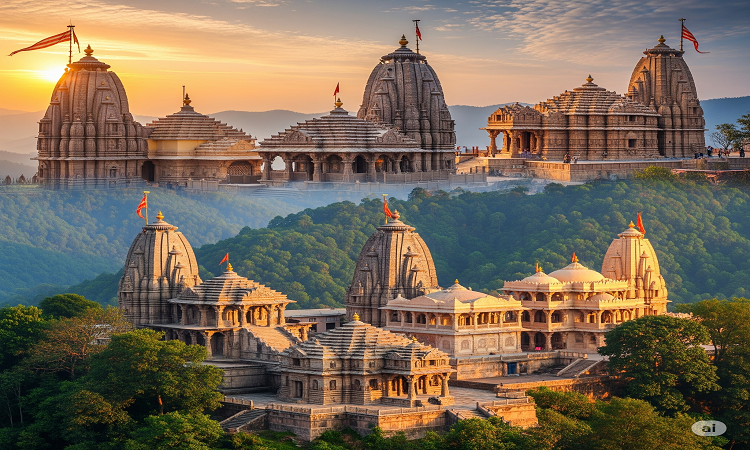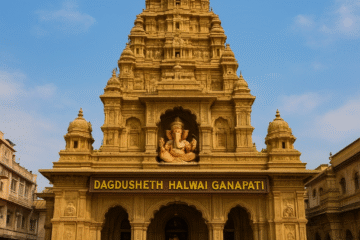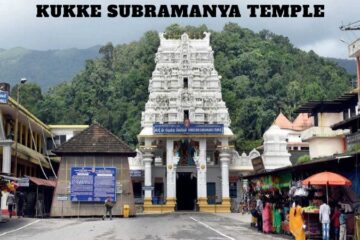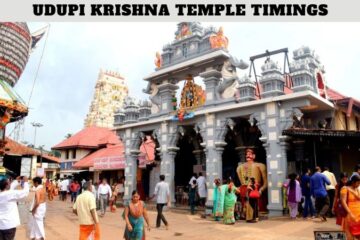
Haridwar, literally meaning “Gateway to God,” is one of India’s most revered pilgrimage sites. Nestled at the foothills of the Himalayas in Uttarakhand, it’s where the sacred River Ganga makes its first appearance on the plains. This ancient city is a vibrant tapestry of spiritual fervor, ancient traditions, and breathtaking natural beauty, drawing millions of devotees and tourists annually. While the famed Har Ki Pauri Ghat is undoubtedly the pulsating heart of Haridwar, where the mesmerizing Ganga Aarti illuminates the evening sky, the city is equally renowned for its myriad temples, each steeped in captivating mythology and historical significance.
For anyone embarking on a spiritual journey or seeking a deeper understanding of Hindu culture, visiting these temples is an indispensable experience. They offer a unique blend of devotion, architectural beauty, and panoramic views, providing a tranquil escape from the bustling city life. This guide delves into the top 5 most famous temples in Haridwar that are an absolute must-visit for every traveler.
1. Mansa Devi Temple
Perched atop the picturesque Bilwa Parvat (Bilwa Hill) of the Shivalik Range, the Mansa Devi Temple is one of the most prominent and highly revered temples in Haridwar. Dedicated to Goddess Mansa Devi, who is believed to be a form of Shakti and emerged from Lord Shiva’s mind, this temple is part of the “Siddhpeeth Triangle” in Haridwar, alongside Chandi Devi and Maya Devi Temples. The term “Siddhpeeth” signifies a place where desires are fulfilled, and it is a common belief that offering prayers here with a pure heart grants all wishes.
Historical Significance and Mythology: The temple’s origins are deeply rooted in Hindu mythology. It is believed that Goddess Mansa Devi is the sister of the Naga (serpent) king Vasuki and a manifestation of Goddess Parvati. Devotees often tie sacred threads around the branches of a tree located within the temple premises, symbolizing their wishes, and return to untie them once their desires are fulfilled, expressing gratitude. The present temple structure was constructed by Maharaja Gopal Singh of Manimajra between 1811 and 1815.
Architecture and Experience: The temple’s architecture is typical of North Indian temple styles, blending seamlessly with its natural surroundings. The main idol of Goddess Mansa Devi is an eight-armed avatar, while another form, a three-headed and five-armed embodiment, is also worshipped. The journey to the temple is an experience in itself. While pilgrims can choose to trek the approximately 3-kilometer winding path from Chandighat, the most popular and convenient way to reach the summit is via the “Mansa Devi Udankhatola,” a thrilling ropeway that offers breathtaking panoramic views of Haridwar city and the meandering Ganga River below. The aerial ascent provides a unique perspective of the holy city and its spiritual landscape.
Best Time to Visit: The temple is open throughout the year, but the best time to visit is during the early morning or late afternoon to avoid crowds and enjoy the serene atmosphere, especially during the months of October to March when the weather is pleasant. Navratri festivals witness a significant surge in devotees.
2. Chandi Devi Temple
Another crucial pillar of the “Siddhpeeth Triangle” and one of the “Panch Tirths” (five pilgrimages) of Haridwar, the Chandi Devi Temple stands majestically atop the Neel Parvat (Neel Hill) of the Shivalik Hills. This temple is dedicated to Goddess Chandi Devi, a fierce form of Goddess Durga, revered for her power to destroy evil.
Historical Significance and Mythology: The legend of Chandi Devi is a tale of divine valor. According to Hindu mythology, this is the very spot where Goddess Chandika (another name for Chandi Devi) vanquished the demon kings Shumbh and Nishumbh. It is said that after defeating the demon Chand-Munda, Goddess Chandika rested here, hence the temple’s establishment to commemorate this victory. While the current temple structure was built in 1929 by King Suchat Singh of Kashmir, the main idol of Goddess Chandi Devi is believed to have been installed in the 8th century by Adi Shankaracharya, the great Indian philosopher and theologian.
Architecture and Experience: Similar to Mansa Devi, reaching the Chandi Devi Temple offers an adventurous journey. Devotees can undertake a challenging 3-kilometer trek from Chandighat, climbing numerous steps, or opt for the “Chandi Devi Udankhatola” ropeway. The ropeway ascent is highly recommended for its spectacular bird’s-eye views of the Haridwar landscape, the winding Ganga, and the surrounding verdant hills. The temple itself, though simply built, exudes a powerful spiritual aura. The views from the top are simply mesmerizing, especially at sunrise or sunset, offering a moment of serene contemplation amidst the divine presence.
Best Time to Visit: Like Mansa Devi, Chandi Devi Temple is most vibrant during the Navratri festivals (March-April and September-October) and during the Kumbh Mela, when thousands of pilgrims flock to seek blessings. The cooler months from October to March are ideal for a comfortable visit.
3. Daksha Mahadev Temple
Located in the town of Kankhal, a short distance from the main Haridwar city, the Daksha Mahadev Temple is a significant pilgrimage site dedicated to Lord Shiva and Goddess Sati. It is one of the oldest and most historically important temples in the region, intimately linked to one of the most pivotal narratives in Hindu mythology concerning Lord Shiva and Sati.
Historical Significance and Mythology: The temple’s name is derived from King Daksha Prajapati, the father of Goddess Sati (Lord Shiva’s first wife). The legend states that King Daksha organized a grand Yagna (fire ritual) but deliberately excluded Lord Shiva, disapproving of his ascetic lifestyle and unconventional appearance. Sati, unable to bear the insult to her beloved husband, immolated herself in the Yagna fire. This act of self-sacrifice enraged Lord Shiva, who, in his furious form of Virabhadra, destroyed the Yagna and beheaded Daksha. Later, upon the pleas of other gods, Shiva resurrected Daksha by replacing his head with that of a goat. The spot where Sati immolated herself is known as Sati Kund, which is located adjacent to the temple and holds immense spiritual significance. The current temple structure was built by Queen Dhankaur in 1810 and later renovated in 1962, but its roots trace back to ancient times, signifying a place where cosmic events unfolded.
Architecture and Experience: The Daksha Mahadev Temple complex is a serene and expansive space. The main temple dedicated to Lord Shiva features a Shivling, the aniconic representation of the deity. The Sati Kund, a sacred tank, is a focal point for devotees, where they offer prayers and perform rituals. Nearby is the Das Mahavidya Temple, dedicated to the ten Mahavidyas, forms of the divine mother. The temple attracts a massive influx of devotees, especially during the month of Sawan (monsoon season, typically July-August) and Maha Shivaratri, when special pujas and celebrations are held. The calm atmosphere, coupled with the profound mythological narrative, makes a visit to Daksha Mahadev Temple a deeply spiritual experience.
Best Time to Visit: The temple is accessible throughout the year. However, the month of Sawan (July-August) and Maha Shivaratri are particularly auspicious for Shaivaite devotees.
4. Maya Devi Temple
The Maya Devi Temple is considered one of the oldest and most sacred temples in Haridwar, giving the city its ancient name, “Mayapuri.” Dedicated to Goddess Maya Devi, the presiding deity of Haridwar, this temple is also a revered Shaktipeeth, forming the third vertex of the Siddhpeeth Triangle along with Mansa Devi and Chandi Devi.
Historical Significance and Mythology: The Maya Devi Temple holds immense mythological importance as it is believed to be the spot where the heart and navel of Goddess Sati fell after Lord Vishnu dismembered her body with his Sudarshan Chakra to stop Lord Shiva’s destructive Tandava dance. This makes it one of the 52 (or 108, depending on the tradition) Shaktipeeths across India, places where parts of Sati’s body are said to have fallen. The temple itself dates back to the 11th century, making it one of the few ancient structures in Haridwar that have remained intact over centuries.
Architecture and Experience: The temple’s architecture reflects traditional North Indian styles, with a simple yet imposing facade. The inner sanctum houses three main idols: Goddess Maya Devi in the center, flanked by Goddess Kali on the left and Goddess Kamakhya on the right. There are also sub-shrines dedicated to other forms of Shakti, including Chamunda and Sheetala Devi. The temple’s ancient roots and its significance as a Shaktipeeth create a powerful spiritual ambiance. Devotees visit here seeking blessings for prosperity, protection, and the fulfillment of desires. Being centrally located near Har Ki Pauri, it is easily accessible and often visited as part of a collective pilgrimage to the three Siddhpeeths.
Best Time to Visit: The temple is open daily from morning until evening. Navratri is a particularly auspicious time to visit, as the temple comes alive with fervent devotion and special rituals.
5. Bharat Mata Mandir
Unlike the other ancient temples dedicated to specific Hindu deities, the Bharat Mata Mandir (Mother India Temple) is a unique and relatively modern shrine in Haridwar, inaugurated in 1983 by the then Prime Minister, Smt. Indira Gandhi. This temple is not dedicated to any traditional deity but to Mother India herself, embodying the spirit of patriotism and national unity.
Unique Aspects and Significance: The Bharat Mata Mandir is an eight-story building, each floor dedicated to a different aspect of India’s glorious heritage, culture, and its revered personalities. This distinctive concept makes it a symbol of “Unity in Diversity” and a place of pilgrimage for patriots as well as spiritual seekers.
- First Floor: Dedicated to Bharat Mata, featuring a majestic statue of Mother India.
- Second Floor (Shoor Mandir): Honors India’s valiant freedom fighters.
- Third Floor (Matru Mandir): Pays homage to the illustrious women of India, such as Meera Bai, Savitri, and Maitri.
- Fourth Floor (Sant Mandir): Showcases the teachings and wisdom of saints from various faiths, including Hinduism, Jainism, Sikhism, and Buddhism, emphasizing religious harmony.
- Fifth Floor (Assembly Hall): Depicts the harmonious coexistence of different religions practiced across India through symbolic murals.
- Sixth Floor: Dedicated to Goddess Shakti in her myriad forms.
- Seventh Floor: Dedicated to Lord Vishnu, the preserver.
- Eighth Floor: Dedicated to Lord Shiva, the ultimate deity.
Architecture and Experience: Standing at a height of 180 feet, the temple’s architectural grandeur is impressive. Visitors can ascend through the various floors, gaining insights into India’s rich history, diverse spiritual traditions, and national heroes. The top floor offers a panoramic view of Haridwar city and the surrounding natural landscape, including glimpses of the Rajaji National Park. The Bharat Mata Mandir is not just a place of worship but a cultural and educational center that promotes national pride and unity.
Best Time to Visit: The temple is open year-round. It’s an excellent place to visit for anyone interested in India’s cultural tapestry and patriotic spirit.
Conclusion
Haridwar’s spiritual landscape is incredibly rich and diverse, with each temple offering a unique narrative and experience. While Har Ki Pauri remains the quintessential Haridwar experience, these five temples — Mansa Devi, Chandi Devi, Daksha Mahadev, Maya Devi, and Bharat Mata Mandir — provide deeper insights into the city’s spiritual heart. From ancient mythological tales of divine power and sacrifice to modern tributes to national unity, these sanctuaries are not just places of worship but living testaments to India’s enduring faith and heritage. A visit to these top temples is an enriching journey that promises spiritual solace, breathtaking views, and a profound connection to the divine energy that permeates this holy city. Whether you’re a devout pilgrim or a curious traveler, the temples of Haridwar beckon, promising an unforgettable spiritual odyssey.


